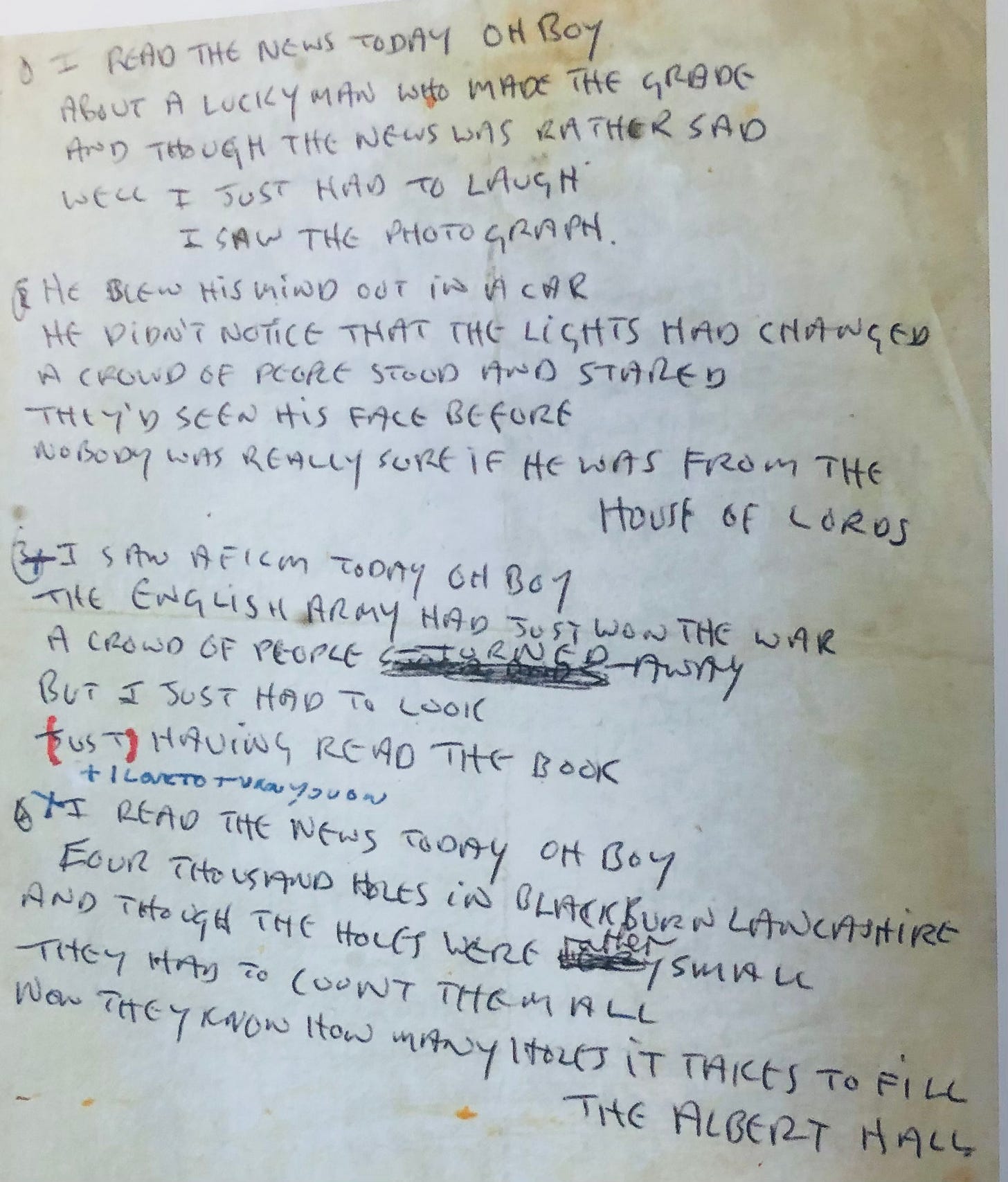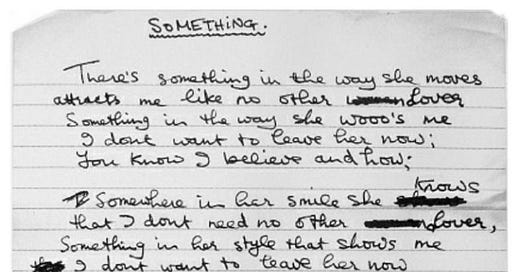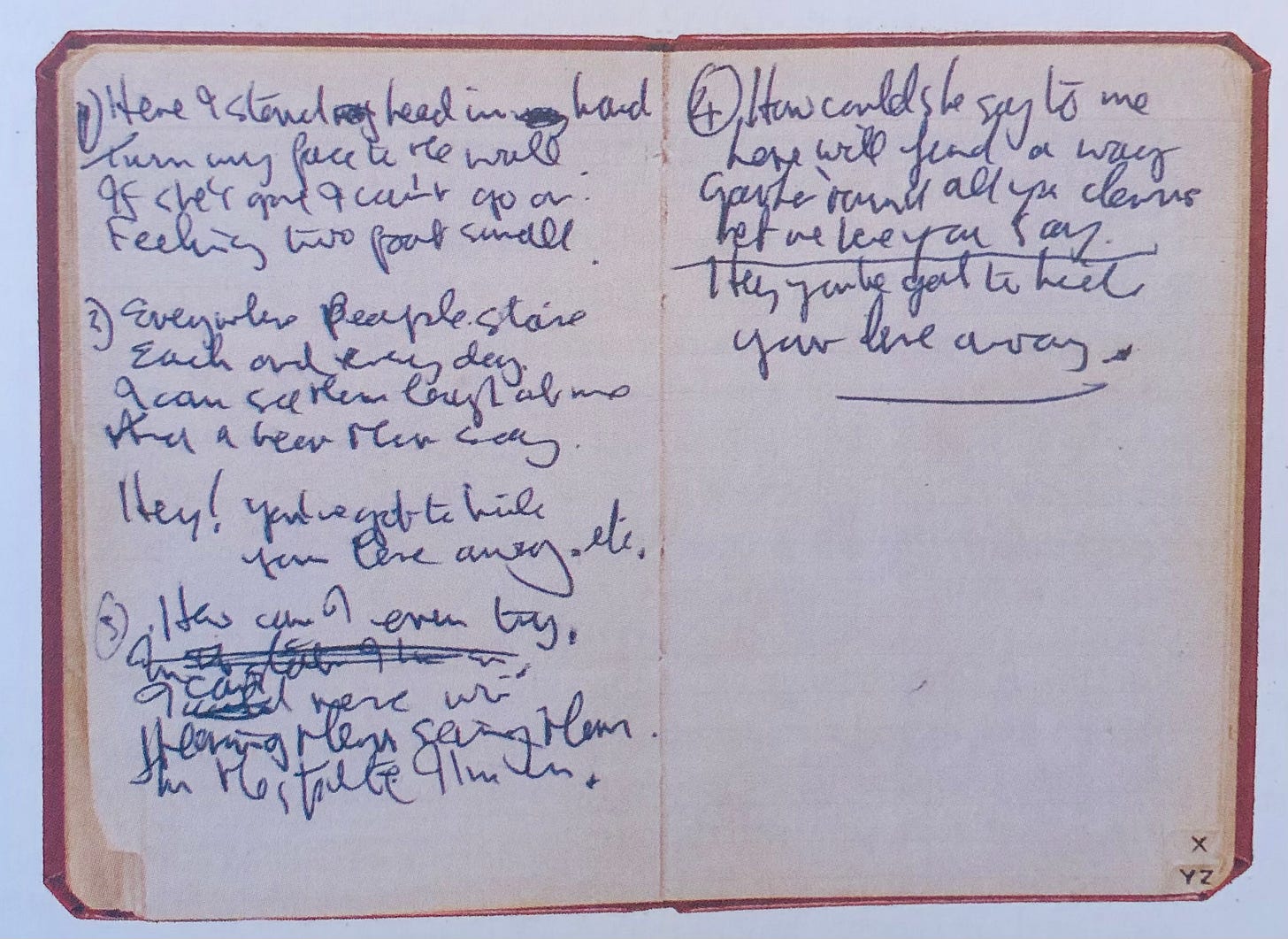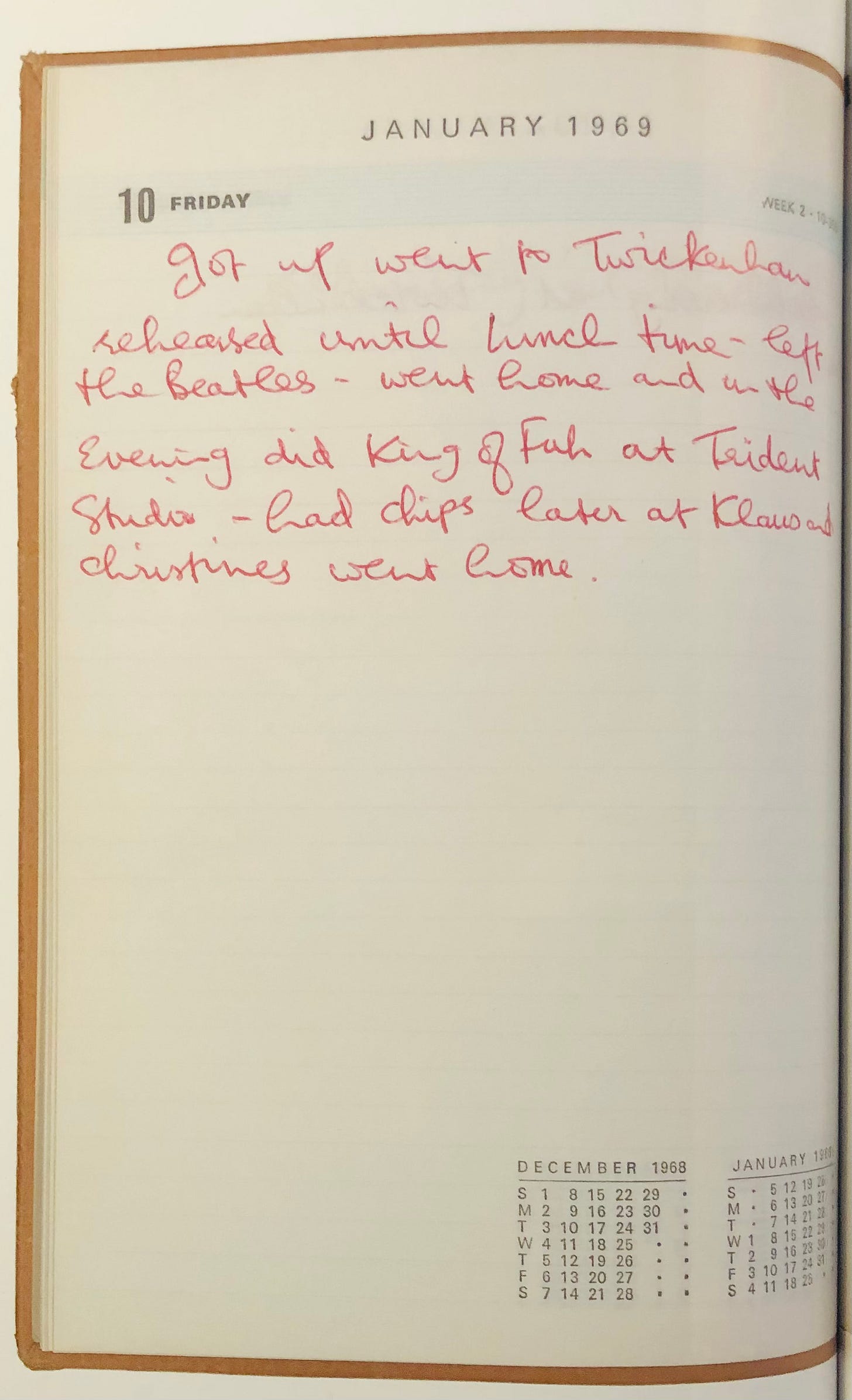Re-Noted: The Beatles' Collaborative Notes: 3 Ways to Write a Song
"Just say whatever comes into your head each time..."
It’s hard to think of a band as wildly productive as The Beatles—especially considering that they were only together for ten years.
Two years ago, I wrote about John Lennon’s childhood notebooks and his love notes. I found John’s personal notes so fascinating, I didn’t get to dig into The Beatles’ notes. A follow up post was in order. This is it!
I’ve consolidated a few of the tips I gathered from researching John and the Beatles. Join me as I explore the notes and the stories behind some of the Beatles’ greatest hits.
1) Let the Lyrics Simmer
I’ve noticed many writers step away from a project when they are stumped. Even Lennon described it as part of his process. He explained:
I just scribble on a bit of paper, you know…And then leave it in a sort of pile. And when it begins to be more interesting, I venture onto the typewriter and type it out. And the typewriter adds things, too. I change it as I type it. It’s usually the third draft when I get to the typewriter.1
This quote also reveals how Lennon used different writing tools at different stages of the process. First, he wrote on scraps of paper. As the work progressed, he’d move to the typewriter.
One of the side-effects of letting a work simmer is that inspiration might strike at any moment. When that happened, Lennon would grab whatever bits of paper he had lying around. In one particular case, John wrote his notes for “You’ve Got to Hide Your Love Away” in his chauffeur’s address book:
And, this is the final version of the song:
Another benefit of walking away from a challenging song for Lennon was that he could wait till he was with Paul McCartney. John explained his writing relationship with Paul:
The way we wrote a lot of the time: you'd write the good bit, the part that was easy, like "I read the news today" or whatever it was, then when you got stuck or whenever it got hard, instead of carrying on, you just drop it; then we would meet each other, and I would sing half, and he would be inspired to write the next bit and vice versa…2
In this quote, John is talking about “A Day in the Life,” which leads me to the next strategy: find inspiration in the news.
2) Cut-Up the Newspaper
“A Day in the Life” begins with a great first line:
I read the news today, oh boy.
This song was reportedly inspired by the death of Tara Brown—a 21 year old heir to the Guinness fortune. But the song’s brilliance comes from the fact that Lennon and McCartney didn’t just copy out the story. They used a cut-up-technique inspired by William Burroughs.3
For “A Day in the Life,” John explains:
I didn't copy the accident…Tara didn't blow his mind out, but it was in my mind when I was writing that verse. The details of the accident in the song – not noticing traffic lights and a crowd forming at the scene – were similarly part of the fiction.4

Reading the newspaper is a start, but it’s not enough to create great art. Just like Burroughs collaged together random bits of sentences to create new texts, John and Paul used their imagination to break-up news stories.
Here is how Paul described Burroughs’s influence:
William S. Burroughs had what he called his ‘cut-up technique’. I have from time to time been a devotee of something along those lines—just dragging words and slinging them around, throwing them up in the air, seeing where they fall. You think, ‘well that can’t mean anything.’ but then you read it, and it does seem to mean something.5
Imagination is key to the next technique as well.
3) Free-Association
After watching all 7+ hours of Peter Jackson’s documentary, Get Back, I feel like I’ve been hanging out with the Beatles (and Yoko). Of course, I loved watching their process: the four of them brainstorming together, playing together, laughing together.
If you watched it, you’ll know that one of the film’s more dramatic scenes comes when George leaves the band. He records it in his diary as though it were an event of little consequence.
got up went to Twickenham rehearsed until lunch time—left the Beatles—went home…
Over the next few days, the rest of the band convinced George to return. Soon, they were in a new studio, writing songs together.
George admits that he struggled to write lyrics.
The words are always a hang-up for me…I’m not very poetic. But I don’t take it seriously. It’s just a joke, personal joke. It’s great if someone else likes it.6
In Get Back, we watch George turn to the rest of the band for help with lyrics for “Something.” He can’t find a word, so this is John’s advice:
Just say whatever comes into your head each time: ‘Attracts me like a cauliflower,’ until you get the word.
Of course—we know now—the words he’s searching for are “no other lover.” In this draft, George is still working it out:
There’s something in the way she moves
attracts me like no other
womanLover
And, here’s the spectacular final version:
Last, but not least, creative work is a special kind of work—it is difficult, but it also bears a strong resemblance to play. Sometimes, it’s all a matter of perspective. I love this bit of wisdom from Paul:
People often say, ‘Oh, you work so hard,’ and I say, ‘We don’t work; we play.’ I try to keep that in the front of my brain when things are getting tiresome. ‘Jesus, we’ve worked too hard. No, we’ve played too hard.’7
Notes on the Beatles’ Notes
Don’t be afraid to take a break from a project: I’ve written about how Mark Twain would often take breaks that lasted multiple years when he was stuck. Luckily for John and Paul, they had each other to turn to. And when The Beatles broke up, it makes sense that they both found new writing partners.
Use different tools for different writing stages: Lennon began drafting ideas on scraps of paper. As the song took shape, he’d switch over to the typewriter. One of the benefits/curses of computers is that our drafts often look similar to the final form (with neatly typed print as opposed to hastily scribbled drafts). I know some writers who choose to begin sketching ideas in a different font (like American Typewriter or Comic Sans) to visually signal that they are writing a draft.
Give chance a chance: Techniques like free-association or Burroughs’s cut-up practice allow us to create unique works at least in part because they break us out of conventions.
You just need a scrap of paper to take notes: I’m as enticed by a beautiful leather-bound notebook as anyone, but the fact remains: some of our best songs, novels, and poems were conceived on cheap scraps of paper —or the pages of a chauffeur’s address book, as the case might be.
Noted is fueled by you. Your ❤️’s and comments inspire me. As always, I would love to know your thoughts.
Yours in Note-Taking,
P.S. Paid subscribers, look out later this week for a deep dive into Paul McCartney’s notes.
Burger, Jeff, and John Lennon. Lennon On Lennon: Conversations With John Lennon. Omnibus Press, 2017.
McCartney, Paul. The Lyrics: 1956 to the Present. Liveright Publishing, 2021. p. 709.
For more on the cut-up technique, check out
’s “The (surprisingly long) history of the cut-up technique”."The Rolling Stone Interview: John Lennon". 21 January 1971.
Davies, Hunter (1968). The Beatles. Columbus: McGraw-Hill. p. 357.
Quoted in The Beatles: The Authorized Biography, p. 321.
Paul McCartney, The Lyrics, p. 559.










I love how you are able to liberate the nuances of peoples processes of developing their ideas. Thank you for you attentiveness it's inspiring.
This casual way of brainstorming extended to when they began to write songs for and perform on each other's solo projects in the 1970s (after the dust of the breakup settled). John, Paul and George all contributed pieces to Ringo's solo works, and George collaborated with Ringo on songwriting (they wrote his first solo #1 hit, "Photograph").